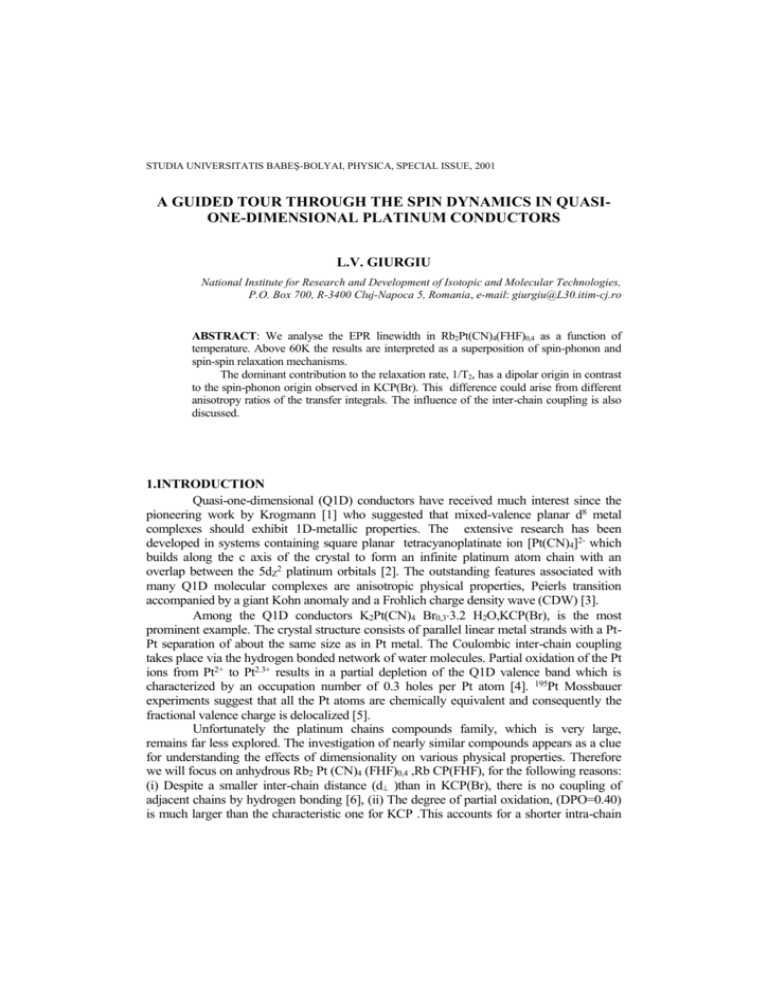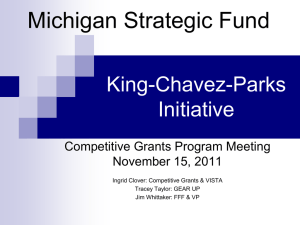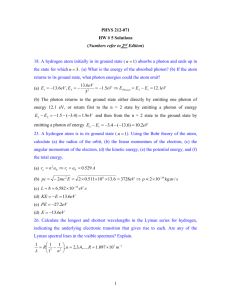MECHANISMS OF THE SPIN RELAXATION IN
advertisement

STUDIA UNIVERSITATIS BABEŞ-BOLYAI, PHYSICA, SPECIAL ISSUE, 2001 A GUIDED TOUR THROUGH THE SPIN DYNAMICS IN QUASIONE-DIMENSIONAL PLATINUM CONDUCTORS L.V. GIURGIU National Institute for Research and Development of Isotopic and Molecular Technologies, P.O. Box 700, R-3400 Cluj-Napoca 5, Romania, e-mail: giurgiu@L30.itim-cj.ro ABSTRACT: We analyse the EPR linewidth in Rb2Pt(CN)4(FHF)0,4 as a function of temperature. Above 60K the results are interpreted as a superposition of spin-phonon and spin-spin relaxation mechanisms. The dominant contribution to the relaxation rate, 1/T2, has a dipolar origin in contrast to the spin-phonon origin observed in KCP(Br). This difference could arise from different anisotropy ratios of the transfer integrals. The influence of the inter-chain coupling is also discussed. 1.INTRODUCTION Quasi-one-dimensional (Q1D) conductors have received much interest since the pioneering work by Krogmann [1] who suggested that mixed-valence planar d8 metal complexes should exhibit 1D-metallic properties. The extensive research has been developed in systems containing square planar tetracyanoplatinate ion [Pt(CN)4]2- which builds along the c axis of the crystal to form an infinite platinum atom chain with an overlap between the 5dZ2 platinum orbitals [2]. The outstanding features associated with many Q1D molecular complexes are anisotropic physical properties, Peierls transition accompanied by a giant Kohn anomaly and a Frohlich charge density wave (CDW) [3]. Among the Q1D conductors K2Pt(CN)4 Br0,33.2 H2O,KCP(Br), is the most prominent example. The crystal structure consists of parallel linear metal strands with a PtPt separation of about the same size as in Pt metal. The Coulombic inter-chain coupling takes place via the hydrogen bonded network of water molecules. Partial oxidation of the Pt ions from Pt2+ to Pt2.3+ results in a partial depletion of the Q1D valence band which is characterized by an occupation number of 0.3 holes per Pt atom [4]. 195Pt Mossbauer experiments suggest that all the Pt atoms are chemically equivalent and consequently the fractional valence charge is delocalized [5]. Unfortunately the platinum chains compounds family, which is very large, remains far less explored. The investigation of nearly similar compounds appears as a clue for understanding the effects of dimensionality on various physical properties. Therefore we will focus on anhydrous Rb2 Pt (CN)4 (FHF)0,4 ,Rb CP(FHF), for the following reasons: (i) Despite a smaller inter-chain distance (d )than in KCP(Br), there is no coupling of adjacent chains by hydrogen bonding [6], (ii) The degree of partial oxidation, (DPO=0.40) is much larger than the characteristic one for KCP .This accounts for a shorter intra-chain L.V. GIURGIU Pt-Pt separation (d|| ) compared with KCP(Br) and implies stronger Pt-Pt bonding [7]. (iii)The presumed linear bifluoride anions (FHF)- could produce a different random potential along the Pt-chains [8]. EPR spectroscopy offers the opportunity to study the magnetic interactions and to obtain informations about the spin-dynamics in Q1D conductors. Earlier EPR investigations of KCP(Br) have revealed the presence of bound dz2- like hole states associated with a valence band of dz2character [9,10].The temperature and the angular dependence of the EPR linewidth in the region above 100K were interpreted as a superposition of the spin-phonon and spin-spin relaxation component in Q1D within the framework of the mixed-valence model [10]. A theory of soliton formation in KCP(Br) and RbCP(FHF) within the one-electron approximation was proposed by us [11].Recently, we have analyzed the temperature dependence of the EPR linewidth in terms of motionally narrowed hyperfine interaction of an unpaired spin soliton delocalized over several platinum nuclei [12]. It has been shown that some of the relaxation and lineshape phenomena observed by NMR in KCP(Br) may be caused either by spin carrying solitons via hyperfine interaction or by spinless solitons via quadrupolar and chemical shift interactions [13]. In order to obtain further insight into the mechanisms responsible for the spin relaxation in Q1D platinum compounds, an EPR investigation of RbCP(FHF) single crystals was carried out. The results are compared with the previous reported ones for KCP(Br) and a discussion of the influence of inter-chain coupling is given. 2.EXPERIMENTAL Single crystals of anhydrous RbCP(FHF) were obtained by an electrolytic procedure [14]. Lustrous metallic gold-colored crystals up to 3-4 mm in length were grown in this manner. X-ray diffraction analysis confirmed the body-centered tetragonal structure (space group I4/mcm) [7,8]. EPR measurements were carried out using a Bruker X-band spectrometer operating with a TE102 cavity. It is equipped with a helium gas-flow cryostat and a homebuilt 2-axis goniometer. The lineshape has been found to be Lorentzian and nearly symmetric throught the investigated temperature range and for both orientations of the external field B || c and B c, where c is the crystal axis of highest electrical conductivity). The almost symmetric shape for small single crystals proves a non-skin-depth limited lineshape.In order to evaluate the EPR-parameters the derivative spectra were fitted with the known Lorentzian lineshape, the fit parameters being the half-width at half-height (HWHH), B1/2 of the corresponding absorbtion line and the resonance field B0 . The relaxation rate 1/T2 was calculated from B1/2 by means of the standard expression [15] . 3.COMPARISON BETWEEN 1D AND 3D CHARACTERISTICS OF RBCP(FHF) AND KCP(BR) Apart from KCP(Br), no other platinum chain compound has been studied by a variety of complementary techniques. In this paper we present an EPR study of RbCP(FHF) and compare the results with the corresponding ones for KCP(Br). The 56 A GUIDED TOUR THROUGH THE SPIN DYNAMICS IN QUASI-ONE-DIMENSIONAL PLATINUM … similarities and differences could be understood in terms of simple changes of the physical parameters, correlating well with expectations based on chemical arguments. In the mean-field scenario, the Peierls instability leads to a second-orderphase transition (metal-insulator or semiconducting state) at the temperature TP. When T<TP a fundamental instability will occcur in the sistem. A periodic lattice distorsion (PLD) results accompanied by a CDW. Also an energy gap, 20 will appear in the electronic spectrum at the Fermi-vector kF corresponding to a Fermi energy EF = 2 k 2 / 2m ,where m is a F effective mass of the charge carriers [4].The Peierls gap gives rise to an activated electrical conductivity (T ) along the Pt-chains.At high temperatures the lattice is undistorted and || || (T ) appears to be rather temperature independent. The metallic conductivity, m is shown in Table 1, together with the other relevant 1-D parameters for both RbCP(FHF) and KCP(Br). Table 1. One-dimensional parameters for the Q1D compounds RbCP(FHF) and KCP(Br) Parameter dII d DPO TP Δ0 kF Ep max Unit Å Å K eV (/dII ) eV -1cm-1 RbCP(FHF) 2.798[7] 8.972[7] 0.10[7] 118[28] 0.018[28] 0.80[28] 2.80[28] 1600-2300[24] KCP(Br) 2.888[28] 9.906[28] 0.30[28] 400[3] 0.072[28] 0.85[28] 3.29[28] 300-350[18,29] In the real Q1D compounds the chains are not completely separated from one another but are present in a crystal lattice and there is, therefore, finite transverse electronic coupling between conducting chains. The 1D fluctuations at low temperatures will create correlated domains over fairly long parts of uncoupled chains. This introduce a 3D character into the system which suppresses fluctuations and leads to a phase transition at T3D, often referred to as the transition temperature at which the Peierls instability manifests itself [3].Introducing a relative electronic transverse coupling constant the dependence of T3D on has been computed by Horowitz et al.[16] In principle one can determine from the ratio T3D /TP and for smal the following expression was derived [16]: 2.5(TP / TF ) ln( TP / T3D ) for 4(TP/TF) (1.) The alternative way of deriving comes from work of Soda et al. [17] where, assuming the electron transport by hopping, the ratio of the conductivity perpendicular and parallel to the c axis is given by: 57 L.V. GIURGIU d 2 d || || 2 (2.) with interchain spacing d and intrachain distance d||. The interchain coupling may occurs either through static coulombic coupling or by electron hopping from chain to chain depending on the chemical nature of the crystal lattice. The results concerning 3D characteristics are summarized in Table 2. Table 2. Three-dimensional parameters for RbCP(FHF) and KCP(Br).The upper and lower parts relate to the teoretical analysis [16] and conductivity data [17], respectively. T3D TP/TF II/ (dII/d ) RbCP(FHF) 80 K[24] 0.004[24] 0.020[18] 10.28[18] - KCP(Br) 100 K[24] 0.007[18] 0.017[18] 104[2] 11.77[18] 0.003[18] The high DPO in RbCP(FHF) will result in a different degree of band filling and hence a different value of EF and of the wavelenght of the associated lattice distorsion compared with KCP(Br) (Table 1). The much smaller value of the activation energy determined for RbCP(FHF) could indicate a weaker electron-phonon coupling. As one can see from Table 2, T3D for the bifluoride complex will occur at lower temperature than in KCP(Br) because of the diminished coupling between the adjacent chains. In RbCP(FHF) d || is 0,1A less in KCP(Br) and no hydrogen bonded network of water molecules exists between the platinum atom chains. Thus, the observed lowering of T3D could confirm the suggestion that Coulombic inter-chain coupling is enhanced by the presence of a hydrogen bonding accros the conducting chains [18].Because of the lower T3D value for RbCP(FHF) there is only a very limited temperature range available for studying the semiconductor region below T3D. One has to consider the above differences between RbCP(FHF) and KCP(Br) in determining the characteristic behaviour of the spin dynamics in Q1D platinum compounds. 4.SPIN RELAXATIONS IN Q1D PLATINUM COMPOUNDS It is well established that the relative magnitude of the dominant processes causing spin relaxation, the spin-phonon and the spin-spin interactions, depends strongly on the dimensionality of the band structure [19,20].One can summarize the theoretical results in the following way. The EPR linewidth is in principle a superposition of a spin-phonon and spin-spin contributions: 58 A GUIDED TOUR THROUGH THE SPIN DYNAMICS IN QUASI-ONE-DIMENSIONAL PLATINUM … 1 1 1 s ph s s T2 T2 T2 (3.) In isotropic metals, the former is caused by the spin-flip scattering of conduction electrons by acoustical phonons, Elliot mechanism, and the spin resonance is determined by the electron-phonon scattering rate [21].It was also shown that for a given scattering rate as determined from the transport properties and for a given spin-orbit coupling, the rate of spin-flip will be much smaller in 1D metals than in 3D systems [19].For systems with flat energy surfaces, it arises from the sharp reduction in one-dimension of the forward (k k') and backward (k - k)scatterings. Deviations from this very small linewidth are allowed by the introduction of 3D character due to the interchain hopping motions of electrons. The high anisotropy of the conductivity in Q1D compounds has an opposite effect on the spin-spin dipolar component of the linewidth. The effects of dimensionality on motional narrowing of dipolar broadening were investigated for magnetic insulators [22] and organic conductors [19].The result is the following: the anisotropy can significantly increase the dipolar linewidth i.e. 1D narrowing by spin diffusion is much less effective than 3D spin diffusion having the same correlation time. The Q1D nature of platinum chain compounds has, therefore, two opposing effects on the effective linewidth: reduction of the rate of spin-phonon relaxation and enhancement of the dipolar contribution. Which mechanism dominates the linewidth will depend on the deviation of the Fermi surface from planarity and on the magnitude of the spin-orbit coupling. In what follows we examine the spin-phonon and spin-spin relaxation rates in terms of the discussions given in [10,19]. 4.1 SPIN - PHONON RELAXATION A strong spin-orbit coupling, as evidenced in platinum compounds by the large anisotropy of g factor [9],contributes to the 3D spin-relaxation through the Elliot mechanism and the corresponding spin-phonon relaxation rate is given by 1 s ph T2 a (g) 2 R1 (4.) where g is the isotropic g - shift, a is a constant of the order of 1 or 30 in 3D metals and R is the 3D scaterring time. g was evaluated to be of the order .g / E where is the spin-orbit coupling constant and E the separation to the nearest band with the same transformation properties. 1 In Q1D case one could assume that can be expressed [23] by R R1 || 1 (5.) 59 L.V. GIURGIU where is the scattering time which contributes to 1D conduction along the chains and and are the inter and intra-chain hopping rates, respectively. If the golden rule || applies [17], then 2 2 2 2 t N (E F ) ; || t N(E F ) || (6) where t and t|| are the transverse and longitudinal transfer integrals, respectively and N(EF ) is the density of states at the Fermi surface. We would like to mention that due to the highly anisotropic nature of the dz2 platinum orbitals, the overlap integral in the c axis direction, is t|| much bigger than t. In terms of the above discussion, Eq. (4) becomes 1 T2s ph t a t || 2 2 1 E (7.) where t || t || 2 (8.) can be considered as the reduction factor of the parameter a due to the one-dimensionality. s ph The temperature dependence of 1 / T is attributed to that of which can be 2 derived from the longitudinal conductivity [17]: ne 2 (9.) || m where n, e and m are the density of carriers, the electron charge and the effective mass, respectively. In the Peierls regime n is expressed by n n 0 exp T (10.) where n0 = 0.4 per Pt-ion corresponds toRbCP(FHF) and is the activation energy. In the metal-insulator transition regime of KCP(Br) it was found that (T) can || be well approximated by an equation given as exp( / T) T3 Combining Eqs. (9) - (11) it results that is proportional to T -3. || (T) (11) The same behaviour holds for RbCP(FHF) in the temperature range 60 - 100K. A fit to Eq. (11) of the corresponding (T ) data [24] results in = 4.5 10-7 sec K3 /T3 || 60 A GUIDED TOUR THROUGH THE SPIN DYNAMICS IN QUASI-ONE-DIMENSIONAL PLATINUM … and = 664 K ( ||max = 2300 -1 cm-1 and free electron mass were considered). It could be compared with the value of 3.2 10-7 sec K3 /T3 which was evaluated for KCP(Br) [10]. Therefore, the temperature dependence of the isotropic spin-phonon contribution to the linewidth,1/ T s ph , can be rewritten as: 2 1 s ph T2 C1T 3 (12.) where t C1 a t || 2 2 3 1 ( T ) E (13) 4.2 SPIN - SPIN RELAXATION It case of 3D conductors, the spin-spin correlation function decays exponentially with a correlation time and when the condition c 2 1/ 2 c 1 ( 2 is the second moment of the resonance line) is met, the lineshape is Lorentzian and the motionally narrowed linewidth is given by [25] 3D 2 c (14) Considering 1D systems in which the spin-spin correlation function obeys a diffusion equation, the narrowing process leads to a non-Lorentzian lineshape with a halfwidth of [22]: 1D Since the ratio 1D 4 3 2/3 2 2/3 1c/ 3 (15) / 3D >>1 (where the same c is considered), the narrowing mechanism is less effective in 1D than in 3D resulting in the enhacement of the dipolar contribution to the effective linewidth. The influence of the inter-chain hopping rate on has been investigated for 1D Q1D conductors [19,20]. Depending on the magnitude of both 1D regimes exist.Appropriate for our investigations is the case and ,three different / 1 (it will be 1D justified a posteriori) which leads to a Lorentzian lineshape and the spin-spin relaxation rate expressed by [19] 1 2 c , s s T2 where ( / ) c c 1/ 2 (16) is the effective spin correlation time. 61 L.V. GIURGIU If the dominant contribution to the dipolar interaction is consideed totake place only along the Pt-chains and considering an axial symmetry for the g-tensor, the angular dependence of 2 2 reads [10] 2 2 1 S(S 1) 2g || g 2 3 2 j 2 g2 || 6 2 rij 3 2 cos 1 , (17) g where g 2 g ||2 cos 2 g 2 sin 2 (18) S is the spin of the magnetic ions, rij are the vectors connecting spins i and j and is the angle between the chain axis c and the magnetic field. Within the framework of the mixed valence model where thermally excited carriers through a finite energy gap contributed to the magnetic properties, the temperature dependence of the mean distance of spins, r could be written as [10]: 1 0,4 exp( / T r n d || 1 exp( / T) 1 (19) with n derived from Eq. 10. Considering Eqs.(16)-(19) ,one arrives at the following expression for the s s temperature dependence of 1 / T 2 2 g 2 1 3 || cos 2 1 exp( / T) C 2 1 exp( / T ) g T2s s (20) where 2 2 2 1 S(S 1) 2g || g 2 0,8 C2 2 d6 c 3 2 || (21) and is assumed to be temperature independent. Finally, the effective relaxation rate as a superposition of the two mechanisms of relaxation reads 2 g 2 1 exp( / T ) || 3 C1T C 2 3 cos 2 1 T2 g 1 exp( / T) (22) 5. RESULTS AND DISCUSSIONS EPR spectra were observed in the 30 - 90 K temperature range and can be interpreted by an axial-spin Hamiltonian with spin S = 1/2. At the lowest temperatures all electrons are expected to be in the CDW condesate and this could be the reason of the 62 A GUIDED TOUR THROUGH THE SPIN DYNAMICS IN QUASI-ONE-DIMENSIONAL PLATINUM … complete vanishing of the electronic paramagnetism below 30 K. At high temperatures close to TP = 118 K, the EPR signal fades out and its detection became difficult. As in the case of KCP(Br) the anisotropic g - factor has an axial-symmetry with the major axis parallel to the c-axis. The principal g-values are consistent with those expected for the dz2 - like hole states mixed due to the spin-orbit coupling with the degenerate dxz , dyz states and are expressed by [26]. g || 2 N 2 3N 2 ( / E) 2 g 2 N 2 6 N( / E) 6N 2 ( / E) 2 (23) where N is the normalization coefficient of the zero-order wave function following spinorbit interaction is the spin-orbit coupling constant and E is the energy separation between a2u(dz2) and the degenerate eu (dxz, dyz) states. The measured g values for RbCP(FHF) together with N and / E parameters deduced by means of Eq.(23) are given in Table 3 and compared with corresponding KCP(Br) data [10].The results show that in both compounds the carriers are holes in dz2like states. Since no temperature dependence of the g - factor can be observed in the limits of experimental accuracy (0.002) the energy difference E is temperature independent. It could means that the atomic displacements are not affected by the presence of localized anharmonic vibration modes, described by a generalized Morse potential [27]. Table 3. Comparison between principal g values, N and / E parameters (Eq.(22)) for Q1D platinum compounds g g N /ΔE RbCP(FHF) 1.951 2.313 0.99 0.063 KCP(Br) 1.945 2.341 0.99 0.068 The temperature dependence of the spin susceptibility, s could be evaluated from the corresponding dependence of the EPR integral intensity I, as determined by double integration of spectra. In Fig.1, ln(I T) is plotted as a function of 1/T above 60 K. The fit of the data to the following equation I const . exp( / T) T (24) gives an activation energy of = 305 K. It is smaller than the value obtained from (T ) analysis (see Sec.4.1). The reason could be that one expects the conductivity to || decrease as fast or faster than the spin susceptibility because any electron that can conduct can flip its spin but not vice versa. However the values of the activation energies should be treated with some reservation because of the narrow temperature range of the fits and the possible sample dependence. We would like to mention that the experimentally observed trend of decreasing 63 L.V. GIURGIU from KCP(Br) (501 K) to RbCP(FHF) is a consequence of the increasing DPO and decreasing d || in this series [24,28]. Fig. 1. Temperature dependence of the EPR integral intensity.The straight line shows the best fit to Eq.(24).The relative intensity I was normalised to the ratio g || / g in order to compare with I ||. With decreasing temperature the EPR linewidth in RbCP(FHF) decreases rapidly, goes through a minimum at Tmin55K and than starts increasing. Such a behaviour was also observed for KCP(Br) where Tmin 85K [9,10]. A comparison of the linewidths B as a function of temperature for RbCP(FHF) and KCP(Br) is shown in Fig.2. 1/ 2 As one can see, the temperature range where the resonances are observed for RbCP(FHF) is narrower than the corresponding one for KCP(Br) in accordance with the previously mentioned difference in the characteristic T3D and TP values between these compounds (Sec.3). 64 A GUIDED TOUR THROUGH THE SPIN DYNAMICS IN QUASI-ONE-DIMENSIONAL PLATINUM … The temperature dependence of the linewidth in KCP(Br) was assumed to arrise from two competing processes which determine the linewidth minimum: a hole-phonon collision broadening and a motional narrowing at high and low temperatures, respectively [9]. Fig.2 Comparison of the temperature dependence of the experimental linewidths B 1/ 2 with B || c () and B c (o) for RbCP(FHF) (open symbols) and KCP(Br) (full symbols).The KCP(Br) data were taken from [9,10] In the following analysis we restrict ourselves to the high temperature regime above 60 K where EPR linewidth could be interpreted as a superposition of the isotropic spin-phonon and anisotropic spin-spin relaxation mechanisms as discussed in Sec.4. The temperature dependence of the effective relaxation rate, 1/T2, is shown in Fig.3 for both orientations of the external magnetic field. The fits to the data (solid lines) using Eq.(22) are consistent with the following parameters: C1 = (250 14) sec-1 K3 and C2= (18.8 0.9) 109sec-1. Here we have taken 305K as resulting from the temperature dependence of the EPR integral intensity. These could be compared with the corresponding values of 800sec-1 K-3 and 5.6 109 sec-1 reported for KCP(Br) [10]. Considering our results and making contact with Eq.( 12) and (16), one has to conclude that the dominant contribution to the linewidth is of spin-spin origin (85%) 65 L.V. GIURGIU By using C1 -value, / E shown in Table 3, a 30 appropriate for alkali metals and as evaluated before, one gets / = 0.945 10-3 for the reduction factor due to the || one-dimensionality. We estimate for the effective correlation time, ( ) 1/ 2 c c a value of 1.6 10-10 sec by means of Eq.(21) and C2. Since is the correlation time of the c dipolar field acting on an individual spin, one could consider as the intra-chain hopping c time. This leads to ( || ) 1 / 2 which allows us to determine and separately. || The anisotropy ratio of the transfer integrals derived from Eq.(8) together with the inter and intra-chain hopping rates as resulting from the above analysis are given in Table 4 in comparison with KCP(Br) values [10] . Fig.3 Temperature dependence of the experimental 1/T2 relaxation rates with B || c () and B c (o) for RbCP(FHF).The solid lines represent the best fit to Eq.(22) The finding that the spin-phonon relaxation mechanism does not dominate the relaxation rate, as it was the case for KCP(Br), is quite surprising. Since the spin orbit coupling and the scattering times are comparable the only justification for this difference is a reduced anisotropy ratio of the transfer integrals, t / t in RbCP(FHF) (Table 4). It could || arise from two processes. One might immediately think of a smaller t - value because there is no coupling of adjacent Pt-chains by hydrogen bonded network of water molecules. A weaker interchain 66 A GUIDED TOUR THROUGH THE SPIN DYNAMICS IN QUASI-ONE-DIMENSIONAL PLATINUM … interaction in RbCP(FHF) than in KCP(Br) should result in a smaller hopping rate, , and exactly such a behaviour can be seen from Table 4. This will not only reduce the spinphonon interaction but will increase the dipolar contribution. Next one has to consider that the shorter d|| (Table 1) implies a stronger Pt-Pt bonding which could increase t ||. Undoubtedly, our results are in agreement with the theoretical model of the linewidth dependence on dimensionality which for small t/t|| precludes the possibility that the spin-phonon contribution to the relaxation rate to be dominant . The significant increase of the dipolar linewidth can be related to a higher anisotropy in the band structure. It could imply that the band structure of RbCP(FHF) is more one-dimensional than the corresponding one for KCP(Br). Table 4. Experimentaly determined t / t|| , and || values for RbCP(FHF) and KCP(Br) as discussed in the text. t/tII [sec-1] II[sec-1] RbCP(FHF) 0.030 1.9• 108 2.1• 1011 KCP(Br) 0.043 5.5• 108 3.1• 1011 We would like to mention that a similar behaviour was found in organic conductors. Here, the spin-relaxation mechanism in TTF - halides and pseudohalides was shown to have a dipolar origin in contrast to the spin-phonon dominated linewidth in TTFTCNQ [19]. The one-dimensionality of TTF-TCNQ is of the same order (t / t|| 0.042) as that of KCP(Br) [17]. We are ready now for justifying a posteriori the condition / 1 used to 1D derive the expression of the motionally narrowed dipolar line in the presence of the interchain coupling Eq.(11). Considering the estimated value of (Table 4) one gets 1D / 0.25 and 1.4 at 60 K and 90 K, respectively. The condition 2 1/ 2 c 1 is also fulfilled in the measured temperature range. 6.CONCLUSIONS The spin-relaxation mechanism and the influence of the inter-chain coupling were investigated by EPR in the anhydrous Q1D compound RbCP(FHF) and compared with KCP(Br). The g factor analysis shows that the carriers are holes in dz2- like states mixed with the degenerate dxz, dyz states through the spin-orbit coupling. EPR linewidth can be measured in the temperature range between 30 and 90K and goes through a minimum at Tmin 55K The temperature dependence of the effective relaxation rates, 1/T2 in the high temperature regime above 60K could be understood as a superposition of the isotropic spin-phonon and anisotropic spin-spin relaxation mechanisms. Taking into consideration the experimental results and theoretical analysis, the dominant contribution to the relaxation rate was found to have a spin-spin origin (85 %) 67 L.V. GIURGIU in contrast to the spin-phonon dominated linewidth observed in KCP(Br).This difference between the mechanisms of the relaxation could arise from different anisotropy ratios of the transfer integrals, t / t|| , the one-dimensionality of RbCP(FHF) being higher than that of KCP(Br). A weaker interchain interaction (smaller hopping rate) due to the absence of coupling between Pt-chains by hydrogen bonding in RbCP(FHF) will reduce the spinphonon interaction and increase the spin-spin contribution. ACKNOWLEDGEMENT L.V. Giurgiu gratefully acknowleges the financial support by the joint visiting scientist program of the Max-Planck-Institute and the University of Stuttgart. R E FER EN CE S [1] Krogmann K.: Angew. Chem. Int. Ed. Engl. 8, 35-42(1969) [2] Zeller H.R.: Festkorperprobleme 13, 31-58 (1973) [3] Toombs G.A.: Phys. Rep. 40, 181-240 (1978) [4] Krogmann K., Hausen H.D.: Z. Anorg. Allgem. Chem. 358, 67-81 (1968) [5] Ruegg W., Kuse D., Zeller H.R.: Phys. Rev. B8, 952-955 (1973) [6] Williams J.M., Schultz A.J.: Molecular Metals, p.337-368, Hatfield W.E. eds, New York: Plenum Press 1979 [7] Williams J.M., Gerrity D.P., Schultz A.J.: J. Am. Chem. Soc. 99, 1668-1669 (1977) [8] Schultz A.J., Coffey C.C., Lee G.C., Williams J.M.: Inorg. Chem. 16, 2129-2131 (1997) [9] Mehran F., Scott B.A.: Phys. Rev. Lett. 31, 1347-1349 (1973) [10] Takahashi T., Doi H., Nagasawa H.: J. Phys. Soc. Jpn. 48, 423-429 (1980) [11] Pana O., Giurgiu L.V., Mehring M.: Solid State Commun. 84, 651-655 (1992) ; 119, 553-557 (2001) [12] Pana O., Kessler C., Filip C., Giurgiu L.V., Ursu I., Mehring M.: Appl. Magn. Reson. 12, 247253 (1997) [13] Mehring M. in: Proc. VII AMPERE Summer School, p.211-215 , Portoroz, Slovenia 1992; Mehring M., Kanert O. Mali M., Brinkmann D.: Solid State Commun. 33, 225-228 (1980) [14] Coffey C.C., Williams J.M.:Inorg. Synth. 20, 25-26 (1979) [15] Poole C.P. Jr.: ESR - A Comprehensive Treatise on Experimental Techniques, 2nd edn., p.592, John Willey & Sons 1983 [16] Horovitz B., Gutfreund H., Weger M.: Phys. Rev. B12, 3174-3185 (1975) [17] Soda G., Jerome D., Weger M., Alizon J., Gallice J., Robert H. Fabre J.M., Giral L.: J. Phys. 38, 933-948 (1977) [18] Karneiro K., Peterson A.S., Underhill A.E., Wood D.J., Watkins D.M., Mackensie G.A.: Phys. Rev. B19, 6279-6287 (1979) [19] Tomkiewicz Y., Taranko A.R.: Phys. Rev. B18, 733-742 (1978) [20] Tomkiewicz Y.: Phys. Rev. B19, 4038-4048 (1979) [21] Elliott R.J.: Phys. Rev. 96, 266-279 (1954) [22] Hennessy M.J., McElwee C.D., Richards P.M.: Phys. Rev. B7, 930-947 (1973) 68 A GUIDED TOUR THROUGH THE SPIN DYNAMICS IN QUASI-ONE-DIMENSIONAL PLATINUM … [23] Bloch A.N., Carruthers T.F., Poehler T.O., Cowan D.O.: Chemistry and Physics of One-Dimensional Metals, p.47-86, Keller H.J. eds., 1976 [24] Wood D.J., Underhill A.E., Schultz A.J., Williams J.M.: Solid State Commun. 30, 501-504 (1979) [25] Kubo R., Tomita K.: J. Phys. Soc. Jpn. 9, 888-919 (1954) [26] Krigas T., Rogers M.T.: J. Chem. Phys.55, 3035-3044 (1971); Giurgiu L.V., Nicula A. Studia Univ. Physica 2, 63-67 (1978) [27] DeAbreu C.D., Pinhal N.M., Vugman N.V.: J. Mag. Reson.100, 588-592, 1992 [28] Underhill A.E., Wood D.J., Carneiro K.: Synth. Met. 1, 395-405 (1979/80) [29] Bereblyum A.S., Buranov L.I., Khidekel M.D., Schegolev I.F., Yakimov E.B.: JETP Lett. 13, 440-442 (1971) 69









